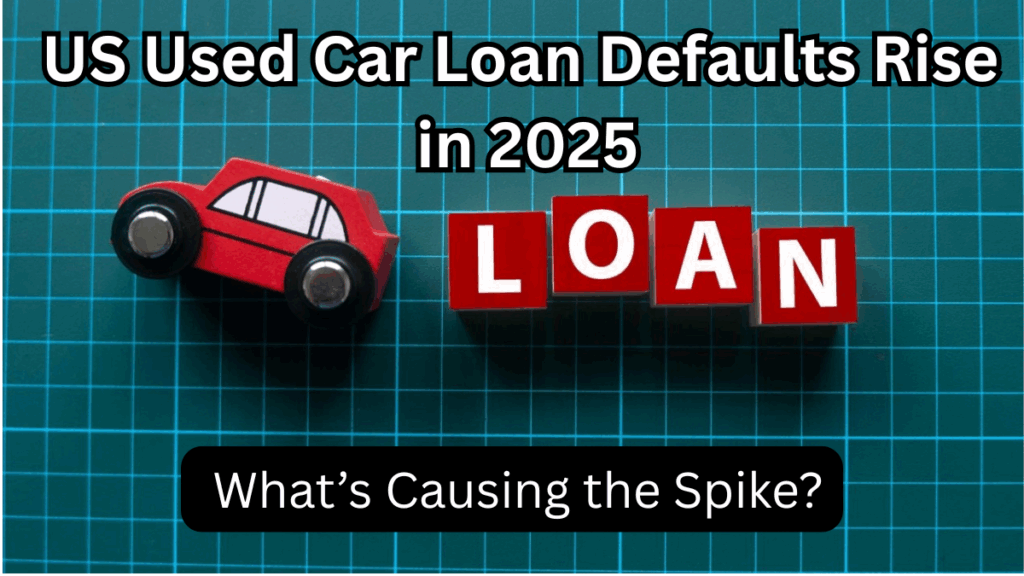The US Used Car Loan Default Rate 2025 is climbing sharply, raising concerns across the auto industry, financial institutions, and buyers. Many Americans are struggling to keep up with their car payments this year, especially in the used vehicle segment. But what’s really behind this sudden surge in loan defaults?
Let’s explore the key factors, the risk increase among buyers, and what this trend means for the used car market.

Table of Contents
Why Are US Used Car Loan Defaults Increasing in 2025?
The risk increase among buyers has been significant in 2025, leading to a noticeable rise in default rates. Several factors have combined to create this situation.
Key Reasons for the Spike:
-
Higher interest rates have made monthly payments more expensive, especially for used cars.
-
Pandemic-driven shortages pushed used car prices to record highs. Many buyers now owe more than their cars are worth.
-
Layoffs and wage stagnation in key sectors have made it harder for some to keep up with payments.
-
Easier credit approvals in recent years increased exposure to high-risk buyers.
-
Higher costs of living have left less room in household budgets for loan repayments.
US Used Car Loan Default Rate 2025 – Key Figures
Here’s a quick look at the latest data on US Used Car Loan Default Rate 2025:
Factor |
Details |
|---|---|
Default Rate (Used Cars) |
Over 6.5% in early 2025 |
Year-on-Year Increase |
Approx. 1.2% rise since 2024 |
Highest Risk Buyer Group |
Subprime credit borrowers |
Impacted Vehicle Segment |
Cars over 5 years old |
How the Risk Increase Among Buyers is Shaping the Market
The risk increase among buyers is now influencing the lending landscape and buyer behavior.
Shifting Lending Practices:
-
Stricter credit score requirements
-
Higher down payment demands
-
Reduced loan approval rates for subprime borrowers
Buyer Reactions:
-
Delayed vehicle purchases
-
Preference for lower-cost vehicles
-
Rising interest in lease-to-own options
Impact on Used Car Prices
As defaults rise, lenders are repossessing more vehicles, increasing used car supply at auctions. This is beginning to soften prices slightly, but the market remains relatively tight.
Trends to Watch:
-
Gradual price corrections in late 2025
-
Increase in repossessed vehicles entering the market
-
Possible easing of inflationary pressures on used car prices
What Can Buyers Do to Stay Safe?
If you’re planning to purchase a used vehicle in 2025, here’s how you can protect yourself:
-
Check your budget thoroughly. Don’t stretch beyond affordable monthly payments.
-
Understand your interest rate. Shop around for better loan terms.
-
Inspect vehicle value. Make sure you’re not overpaying for the car.
-
Avoid high-risk loans. Be cautious with extended loan terms and low/no-down-payment offers.
FAQs
1. Why is the US Used Car Loan Default Rate 2025 increasing?
The US Used Car Loan Default Rate 2025 is increasing due to high-interest rates, overpriced vehicles, inflation pressures, and more lenient lending practices in previous years that exposed lenders to riskier buyers.
2. How can I reduce my risk when taking a used car loan in 2025?
You can minimize risk by opting for shorter loan terms, securing lower interest rates, avoiding overpaying for the vehicle, and ensuring your monthly payments comfortably fit your budget.
3. Who is most affected by the rising defaults?
Buyers with subprime credit scores (typically below 620) are seeing the biggest impact. They face higher interest rates, tighter lending rules, and are more prone to default due to financial instability.
4. Will used car prices fall because of this trend?
There may be a gradual price adjustment later in 2025 as more repossessed cars return to the market, but a dramatic price drop isn’t expected soon due to ongoing supply chain constraints.
Click here to learn more
